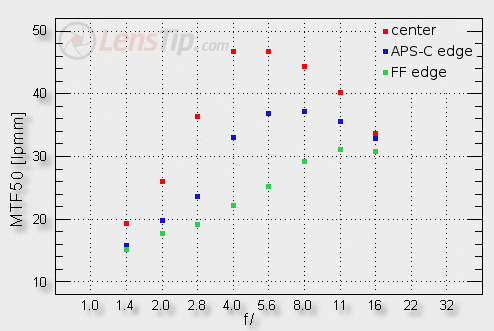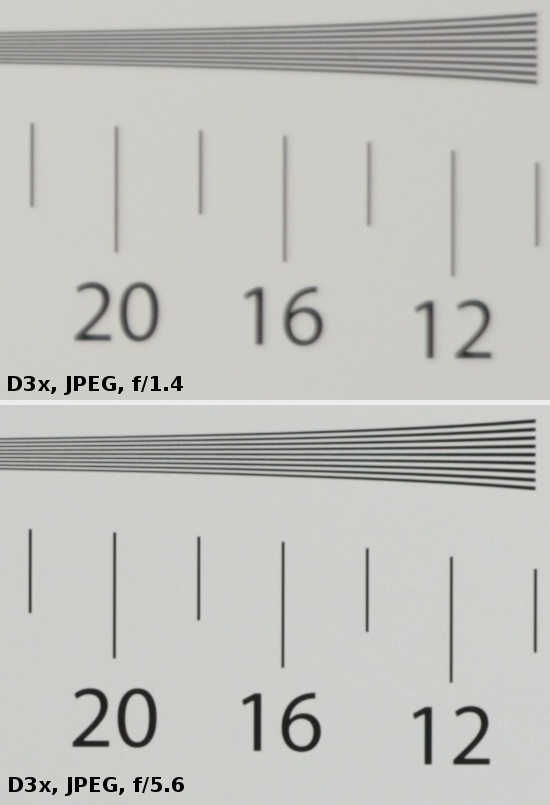Nikon Nikkor AF-S 58 mm f/1.4G
4. Image resolution
The results of the Nikkor AF-S 58 mm f/1.4G are easily comparable to those of the Otus 1.4/55 and the Nikkor AF-S 50 mm f/1.4G, as these lenses were tested in exactly the same conditions and using the same camera body.
Let’s check how the tested lens fares in the frame centre, on the edge of the APS-C/DX sensor and on the edge of full frame. An appropriate graph you can find below.
Please Support UsIf you enjoy our reviews and articles, and you want us to continue our work please, support our website by donating through PayPal. The funds are going to be used for paying our editorial team, renting servers, and equipping our testing studio; only that way we will be able to continue providing you interesting content for free. |
- - - - - - - - - - - - - - - - - - - - - - - - - - - - - - - - - - - - - - - - - - - - - - - -

When it comes to the frame centre, the performance at the maximum relative aperture is disgracefully weak. Even by f/2.0 you are still below the decency level and only the f/2.8 aperture can guarantee you images of good quality. Even the classic Nikkor AF-S 50 mm f/1.4G, much cheaper than the tested lens, was a bit better by f/1.4-2.0. A comparison to the Zeiss Otus is for the Nikkor 1.4/58G simply devastating –even at the maximum relative aperture the Zeiss is able to provide MTFs almost two times higher!
As a consolation you might add that from f/2.2 the image quality, generated by the Nikkor 1.4/58G, improves very quickly on stopping down, reaching its 47 lpmm peak by f/4.0-5.6. That value is noticeably higher than 43 lpmm got by the Nikkor 1.4/50G but, of course, lower than over 50 lpmm reached by the Zeiss Otus.
On the edge of the APS-C and in the range from f/1.4 to 3.5 the image is hardly useful. Good quality performance can be observed only after stopping down to f/5.6-8.0.
When it comes to the results you got on the edge of full frame, they are so weak that you might actually start wondering whether the producer has forgotten to mention the fact that this lens is a first fast 50 mm device designed for APS-C sensors. Otherwise I really don’t know how to interpret the performance of a lens as fast as f/1.4 which has to be closed down to f/8-11 so the image on the very edge of the frame becomes useful. It would be more or less understandable if you dealt with a budget-friendly model, costing e.g. 1000 PLN; in the case of an expensive, modern device which, in addition, is supposed to be as legendary as its excellent predecessor it is simply unacceptable.
It’s worth mentioning here the fact that our test was conducted with the help of testing charts of different sizes so the lens was positioned in different distances from the target. The best results were achieved with the biggest chart, the worst – with the smallest one. The MTFs we present above are averaged out – that’s why our results might be worse than those, presented by other optics testing websites which test their lenses on one big chart or even for infinity and, additionally, they don’t take astigmatism into consideration. We deliberately didn’t test the lens with the smallest chart, available in our studio; otherwise the results would be even worse.
The photo below, taken during the autofocus test, allows you to see how low the image quality is at the maximum relative aperture and minimum focus (click in order to get a 1:1 image). It is difficult to find here any depth of focus because there is no sharp area visible practically anywhere. Only longitudinal chromatic aberration informs us that the lens actually didn’t misfocus. Behind the “0” point the image is greenish and before it – red; it means that the lens focused more or less right.
At the end of this chapter we can play a bit, presenting a visual comparison between the new Nikkor and its predecessors so the Noct-Nikkor 58 mm f/1.2 and the Nikkor 50 mm f/1.2. Below you can find crops from images taken with lenses attached to the Nikon D3x.
| The frame centre – f/1.4 | |||
|
|
|
|
|

|

|

|
|
| The frame centre – f/2.0 | |||
|
|
|
|
|

|

|

|
|
| The frame centre – f/2.8 | |||
|
|
|
|
|

|

|

|
|
It is immediately clear that the new Nikkor AF-S 58 mm f/1.4G is worse than the old Noct Nikkor. I really don’t understand why the Nikon company, employing their best optics specialists, having top-of-the-range technologies available and without any budgetary limits, cannot design a better lens than the Noct-Nikkor – a lens they produced almost 40 years ago, using just paper and pencil. I think something important eludes my comprehension…
Below, traditionally, we present crops taken from photos of our testing chart, saved as JPEG files along with RAW files which we used to generate our resolution graphs.
 |






